A Super Twisting Fractional Order Terminal Sliding Mode Control for DFIG-Based Wind Energy Conversion System
Abstract
:1. Introduction
2. DFIG-Based WECS Modeling
2.1. Wind Turbine Model
2.2. Doubly Fed Induction Generator Model
3. Rotor Side and Grid Side Converter Control
3.1. Speed Control
3.2. Current Control
3.3. Grid Side Control
4. Results and Discussion
4.1. CASE 1
4.2. CASES 2
4.3. Efficiency
5. Conclusions
Author Contributions
Funding
Conflicts of Interest
Appendix A. Basic Definitions for Fractional Calculus
| DFIG and Wind Turbine Parameter | Values | Control Parameters | Values | Control Parameters | Values |
|---|---|---|---|---|---|
| Voltage | 700 V | k | 0.5–5 | c5 | 0.02 |
| No. of pole pairs | 3 | 0.7 | c6 | 5 | |
| Rs | 1.4 Ohm | 0.8 | kr1 | 0.002 | |
| Rr | 1.2 Ohm | 0.1 | kr2 | 0.02 | |
| M | 0.0051839 H | 0.001 | kr3 | 0.006 | |
| Lr = Ls | 0.0053 H | 0.01 | c7 | 0.005 | |
| 0.00015 | 0.2 | c8 | 1 | ||
| J | 765.6 | 0.003 | kr4 | 0.003 | |
| DC Link Voltage (E) | 800 V | 0.001 | |||
| DC Link Capacitor | 0.01 farad | c1 | 0.0015 | ||
| Frequency | 50 Hz | c2 | 5 | ||
| Blade radius | 35 m | c3 | 0.02 | ||
| Gear ratio | 62.5 | c4 | 5 | ||
| 6.325 |
References
- Neij, L. Cost dynamics of wind power. Energy 1999, 24, 375–389. [Google Scholar] [CrossRef]
- Wind Power Capacity Worldwide Reaches 597 GW, 50.1 GW Added in 2018. Available online: https://wwindea.org/information-2/information/ (accessed on 21 April 2020).
- Ullah, N.; Ali, M.A.; Ibeas, A.; Herrera, J. Adaptive fractional order terminal sliding mode control of a doubly fed induction generator-based wind energy system. IEEE Access 2017, 5, 21368–21381. [Google Scholar] [CrossRef]
- Babu, B.C.; Mohanty, K. Doubly-fed induction generator for variable speed wind energy conversion systems-modeling & simulation. Int. J. Comput. Electr. Eng. 2010, 2, 141. [Google Scholar]
- Zaid, M.M.; Ro, J.-S. Switch Ladder modified H-bridge multilevel inverter with novel pulse width modulation technique. IEEE Access 2019, 7, 102073–102086. [Google Scholar] [CrossRef]
- Abad, G.; Rodríguez, M.Á.; Poza, J. Two-level VSC based predictive direct torque control of the doubly fed induction machine with reduced torque and flux ripples at low constant switching frequency. IEEE Trans. Power Electron. 2008, 23, 1050–1061. [Google Scholar] [CrossRef]
- Zhi, D.; Xu, L.; Williams, B.W. Model-based predictive direct power control of doubly fed induction generators. IEEE Trans. Power Electron. 2009, 25, 341–351. [Google Scholar]
- Rodrigues, L.L.; Potts, A.S.; Vilcanqui, O.A.; Sguarezi Filho, A.J. Tuning a model predictive controller for doubly fed induction generator employing a constrained genetic algorithm. IET Electr. Power Appl. 2019, 13, 812–819. [Google Scholar] [CrossRef]
- Madanzadeh, S.; Abedini, A.; Radan, A.; Ro, J.-S. Application of quadratic linearization state feedback control with hysteresis reference reformer to improve the dynamic response of interior permanent magnet synchronous motors. ISA Trans. 2019, 99, 167–190. [Google Scholar] [CrossRef]
- Qin, B.; Sun, H.; Ma, J.; Li, W.; Ding, T.; Wang, Z.; Zomaya, A.Y. robust h∞ control of doubly fed wind generator via state-dependent riccati equation technique. IEEE Trans. Power Syst. 2018, 34, 2390–2400. [Google Scholar] [CrossRef]
- Aidoud, M.; Sedraoui, M.; Lachouri, A.; Boualleg, A. A robustification of the two degree-of-freedom controller based upon multivariable generalized predictive control law and robust H∞ control for a doubly-fed induction generator. Trans. Inst. Meas. Control 2018, 40, 1005–1017. [Google Scholar] [CrossRef]
- Rocha-Osorio, C.; Solís-Chaves, J.; Rodrigues, L.L.; Puma, J.A.; Sguarezi Filho, A. Deadbeat–fuzzy controller for the power control of a Doubly Fed Induction Generator based wind power system. ISA Trans. 2019, 88, 258–267. [Google Scholar] [CrossRef] [PubMed]
- El Azzaoui, M.; Mahmoudi, H. Fuzzy-PI control of a doubly fed induction generator-based wind power system. Int. J. Autom. Control 2017, 11, 54–66. [Google Scholar] [CrossRef]
- Lantewa, N.G.; Magaji, N. Control of doubly fed induction generator of variable speed wind turbine system using neural network. In Proceedings of the 2018 International Conference and Utility Exhibition on Green Energy for Sustainable Development (ICUE), Phuket, Thailand, 24–26 October 2018; pp. 1–6. [Google Scholar]
- Hore, D.; Sarma, R. Neural network–based improved active and reactive power control of wind-driven double fed induction generator under varying operating conditions. Wind Eng. 2018, 42, 381–396. [Google Scholar] [CrossRef]
- Massoum, S.; Meroufel, A.; Youcefa, B.E.; Massoum, A.; Wira, P. Three-level NPC converter-based neuronal direct active and reactive power control of the doubly fed induction machine for wind energy generation. Majlesi J. Electr. Eng. 2017, 11, 25–32. [Google Scholar]
- Douiri, M.R.; Essadki, A.; Cherkaoui, M. Neural networks for stable control of nonlinear dfig in wind power systems. Procedia Comput. Sci. 2018, 127, 454–463. [Google Scholar] [CrossRef]
- Abouheaf, M.; Gueaieb, W.; Sharaf, A. Model-free adaptive learning control scheme for wind turbines with doubly fed induction generators. IET Renew. Power Gener. 2018, 12, 1675–1686. [Google Scholar] [CrossRef] [Green Version]
- Yang, B.; Yu, T.; Shu, H.; Zhang, Y.; Chen, J.; Sang, Y.; Jiang, L. Passivity-based sliding-mode control design for optimal power extraction of a PMSG based variable speed wind turbine. Renew. Energy 2018, 119, 577–589. [Google Scholar] [CrossRef]
- Hu, J.; Nian, H.; Hu, B.; He, Y.; Zhu, Z. Direct active and reactive power regulation of DFIG using sliding-mode control approach. IEEE Trans. Energy Convers. 2010, 25, 1028–1039. [Google Scholar] [CrossRef]
- Davari, M.; Mohamed, Y.A.-R.I. Robust DC-link voltage control of a full-scale PMSG wind turbine for effective integration in DC grids. IEEE Trans. Power Electron. 2016, 32, 4021–4035. [Google Scholar] [CrossRef]
- Da Costa, J.P.; Pinheiro, H.; Degner, T.; Arnold, G. Robust controller for DFIGs of grid-connected wind turbines. IEEE Trans. Ind. Electron. 2010, 58, 4023–4038. [Google Scholar] [CrossRef]
- Sami, I.; Khan, B.; Asghar, R.; Mehmood, C.A.; Ali, S.M.; Ullah, Z.; Basit, A. Sliding mode-based model predictive torque control of induction machine. In Proceedings of the IEEE International Conference on Engineering and Emerging Technologies (ICEET), Lahore, Pakistan, 21–22 February 2019; pp. 1–5. [Google Scholar]
- Kassem, A.M.; Hasaneen, K.M.; Yousef, A.M. Dynamic modeling and robust power control of DFIG driven by wind turbine at infinite grid. Int. J. Electr. Power Energy Syst. 2013, 44, 375–382. [Google Scholar] [CrossRef]
- Ardjoun, S.A.E.M.; Abid, M. Fuzzy sliding mode control applied to a doubly fed induction generator for wind turbines. Turk. J. Electr. Eng. Comput. Sci. 2015, 23, 1673–1686. [Google Scholar] [CrossRef]
- Djoudi, A.; Chekireb, H.; Bacha, S. Low-cost sliding mode control of WECS based on DFIG with stability analysis. Turk. J. Electr. Eng. Comput. Sci. 2015, 23, 1698–1714. [Google Scholar] [CrossRef]
- Barambones, O.; Cortajarena, J.; Alkorta, P.; de Durana, J. A real-time sliding mode control for a wind energy system based on a doubly fed induction generator. Energies 2014, 7, 6412–6433. [Google Scholar] [CrossRef]
- Shang, L.; Hu, J. Sliding-mode-based direct power control of grid-connected wind-turbine-driven doubly fed induction generators under unbalanced grid voltage conditions. IEEE Trans. Energy Convers. 2012, 27, 362–373. [Google Scholar] [CrossRef]
- Pande, V.; Mate, U.; Kurode, S. Discrete sliding mode control strategy for direct real and reactive power regulation of wind driven DFIG. Electr. Power Syst. Res. 2013, 100, 73–81. [Google Scholar] [CrossRef]
- Mohd Zaihidee, F.; Mekhilef, S.; Mubin, M. Robust speed control of PMSM using sliding mode control (SMC)—A review. Energies 2019, 12, 1669. [Google Scholar] [CrossRef] [Green Version]
- Beltran, B.; Benbouzid, M.E.H.; Ahmed-Ali, T. Second-order sliding mode control of a doubly fed induction generator driven wind turbine. IEEE Trans. Energy Convers. 2012, 27, 261–269. [Google Scholar] [CrossRef] [Green Version]
- Evangelista, C.; Valenciaga, F.; Puleston, P. Active and reactive power control for wind turbine based on a MIMO 2-sliding mode algorithm with variable gains. IEEE Trans. Energy Convers. 2013, 28, 682–689. [Google Scholar] [CrossRef]
- Abdeddaim, S.; Betka, A. Optimal tracking and robust power control of the DFIG wind turbine. Int. J. Electr. Power Energy Syst. 2013, 49, 234–242. [Google Scholar] [CrossRef]
- Boudjema, Z.; Taleb, R.; Djeriri, Y.; Yahdou, A. A novel direct torque control using second order continuous sliding mode of a doubly fed induction generator for a wind energy conversion system. Turk. J. Electr. Eng. Comput. Sci. 2017, 25, 965–975. [Google Scholar] [CrossRef] [Green Version]
- Dahiya, P.; Sharma, V.; Naresh, R. Methods, Hybridized gravitational search algorithm tuned sliding mode controller design for load frequency control system with doubly fed induction generator wind turbine. Optim. Control Appl. 2017, 38, 993–1003. [Google Scholar] [CrossRef]
- Kwon, H.-S.; Ro, J.-S.; Jung, H.-K. A novel social insect optimization algorithm for the optimal design of an interior permanent magnet synchronous machine. IEEE Trans. Magn. 2018, 54, 1–6. [Google Scholar] [CrossRef]
- Taleb, M.; Hbib, M.; Cherkaoui, M.; Taleb, M. Power flow control in wind energy conversion systems using PSO optimized adaptive sliding mode control. In 2018 Renewable Energies, Power Systems & Green Inclusive Economy (REPS-GIE); IEEE: Piscataway, NJ, USA, 2018; pp. 1–5. [Google Scholar]
- Mozayan, S.M.; Saad, M.; Vahedi, H.; Fortin-Blanchette, H.; Soltani, M. Sliding mode control of PMSG wind turbine based on enhanced exponential reaching law. IEEE Trans. Ind. Electron. 2016, 63, 6148–6159. [Google Scholar] [CrossRef]
- Belgacem, K.; Mezouar, A.; Essounbouli, N. Design and analysis of adaptive sliding mode with exponential reaching law control for double-fed induction generator based wind turbine. Int. J. Power Electron. Drive Syst. 2018, 9, 1534. [Google Scholar] [CrossRef]
- Liu, Y.; Wang, Z.; Xiong, L.; Wang, J.; Jiang, X.; Bai, G.; Li, R.; Liu, S. DFIG wind turbine sliding mode control with exponential reaching law under variable wind speed. Int. J. Electr. Power Energy Syst. 2018, 96, 253–260. [Google Scholar] [CrossRef]
- Xiong, L.; Li, P.; Li, H.; Wang, J. Sliding mode control of DFIG wind turbines with a fast exponential reaching law. Energies 2017, 10, 1788. [Google Scholar] [CrossRef] [Green Version]
- Chaal, H.; Jovanovic, M. Direct power control of brushless doubly-fed reluctance machines. In Proceedings of the Power Electronics, Machines and Drives (PEMD 2010), 5th IET International Conference, Brighton, UK, 19–21 April 2010. [Google Scholar]
- Bai, J.; Feng, X.-C. Fractional-order anisotropic diffusion for image denoising. IEEE Trans. Image Process. 2007, 16, 2492–2502. [Google Scholar] [CrossRef]
- Miller, K.S.; Ross, B. An Introduction to the Fractional Calculus and Fractional Differential Equations; Wiley: Hoboken, NJ, USA, 1993. [Google Scholar]
- Delghavi, M.B.; Shoja-Majidabad, S.; Yazdani, A. Fractional-order sliding-mode control of islanded distributed energy resource systems. IEEE Trans. Sustain. Energy 2016, 7, 1482–1491. [Google Scholar] [CrossRef]
- Aghababa, M.P. A Lyapunov-based control scheme for robust stabilization of fractional chaotic systems. Nonlinear Dyn. 2014, 78, 2129–2140. [Google Scholar] [CrossRef]
- Ebrahimkhani, S. Robust fractional order sliding mode control of doubly-fed induction generator (DFIG)-based wind turbines. ISA Trans. 2016, 63, 343–354. [Google Scholar] [CrossRef]
- Asghar, M. Performance comparison of wind turbine based doubly fed induction generator system using fault tolerant fractional and integer order controllers. Renew. Energy 2018, 116, 244–264. [Google Scholar] [CrossRef]
- Hosseinabadi, M.; Rastegar, H. DFIG based wind turbines behavior improvement during wind variations using fractional order control systems. Irani J. Electr.and Electron. Eng. 2014, 10, 314–323. [Google Scholar]
- Pashchenko, D. Ansys Fluent CFD modeling of solar air-heater thermoaerodynamics. Appl. Sol. Energy 2018, 54, 32–39. [Google Scholar] [CrossRef]
- Lima, F.; Watanabe, E.H.; Rodriguez, P.; Luna, A. A simplified model for wind turbine based on doubly fed induction generator. In Proceedings of the 2011 International Conference on Electrical Machines and Systems, Beijing, China, 20–23 August 2011; pp. 1–6. [Google Scholar]
- Ullah, N.; Ali, M.A.; Ahmad, R.; Khattak, A. Fractional order control of static series synchronous compensator with parametric uncertainty. IET Gener. Transm. Distrib. 2017, 11, 289–302. [Google Scholar] [CrossRef]
- Mesemanolis, A.; Mademlis, C.; Kioskeridis, I. High-efficiency control for a wind energy conversion system with induction generator. IEEE Trans. Energy Convers. 2012, 27, 958–967. [Google Scholar] [CrossRef]
- Matignon, D. Stability properties for generalized fractional differential systems. ESAIM Proc. 1998, 5, 145–158. [Google Scholar] [CrossRef] [Green Version]
- Zhang, F.; Li, C. Stability analysis of fractional differential systems with order lying in (1, 2). Adv. Differ. Equ. 2011, 2011, 213485. [Google Scholar] [CrossRef] [Green Version]
- Podlubny, I. Geometric and physical interpretation of fractional integration and fractional differentiation. arXiv 2001, arXiv:math/0110241. [Google Scholar]
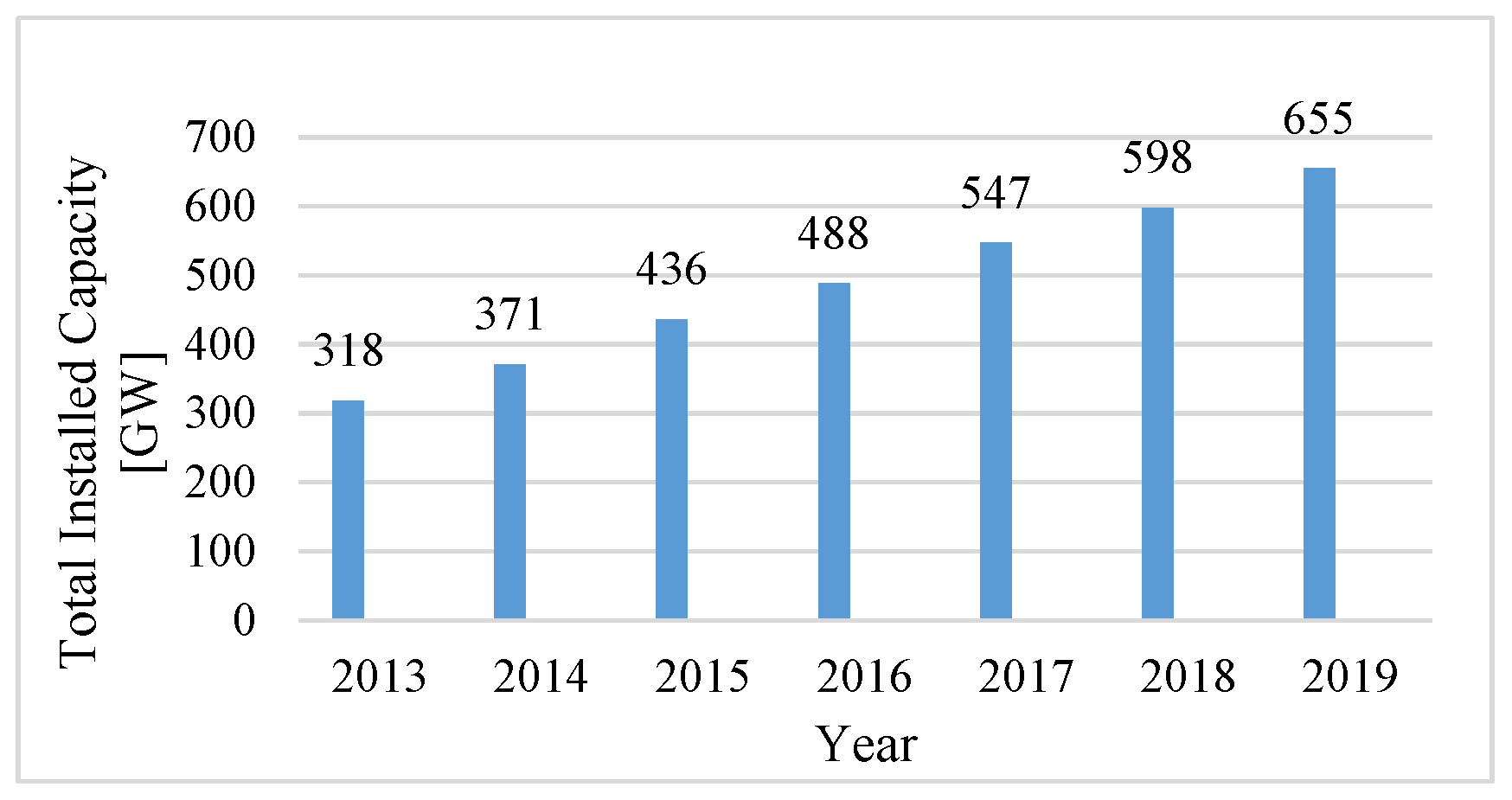
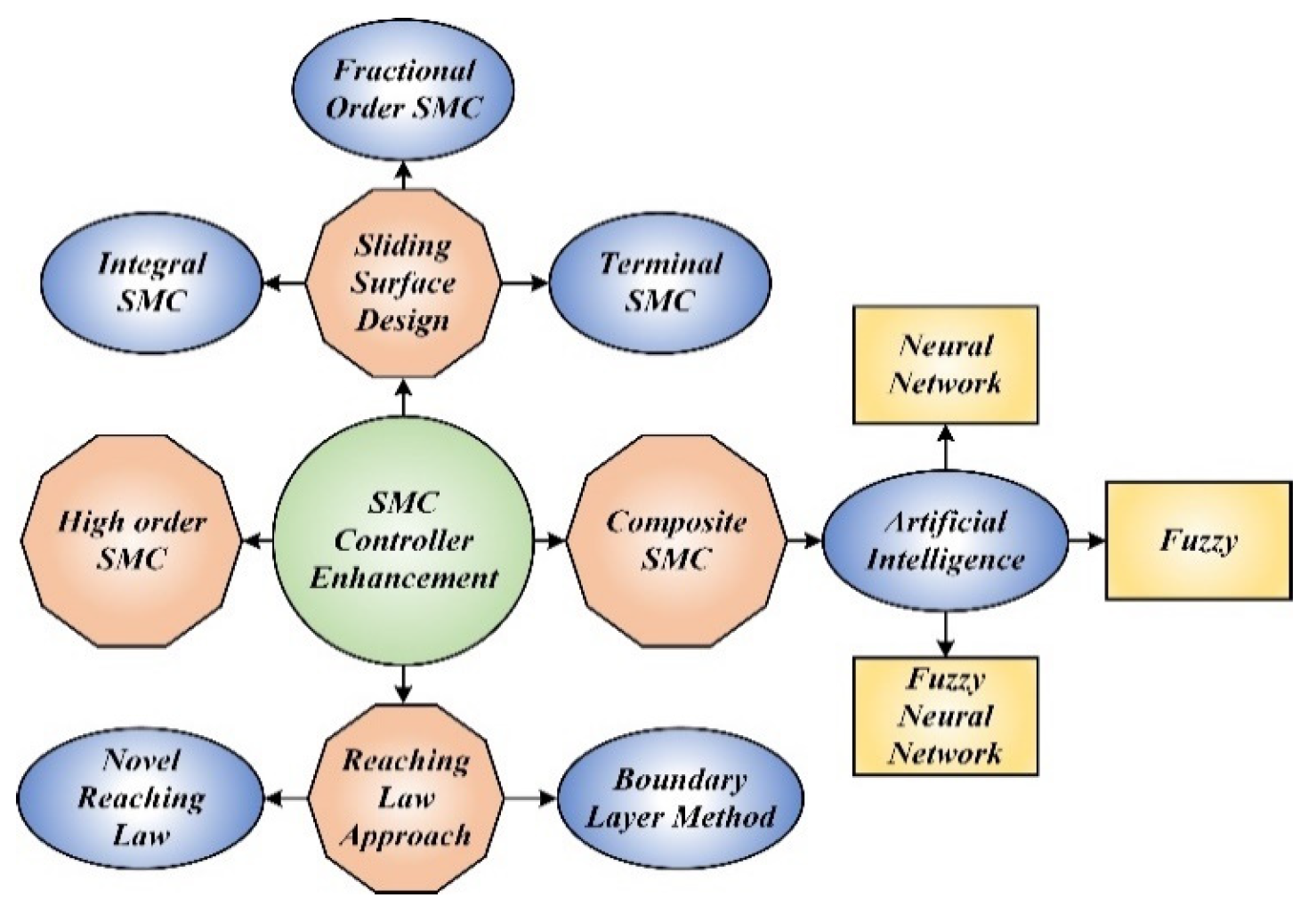








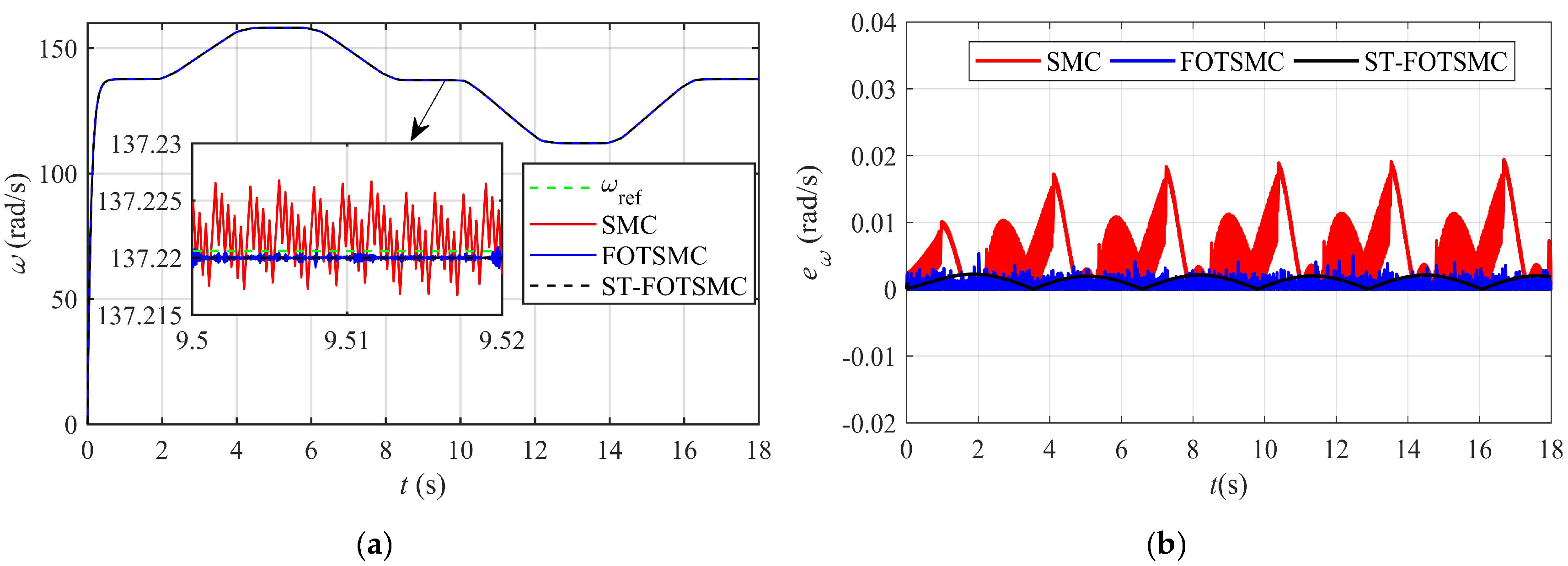
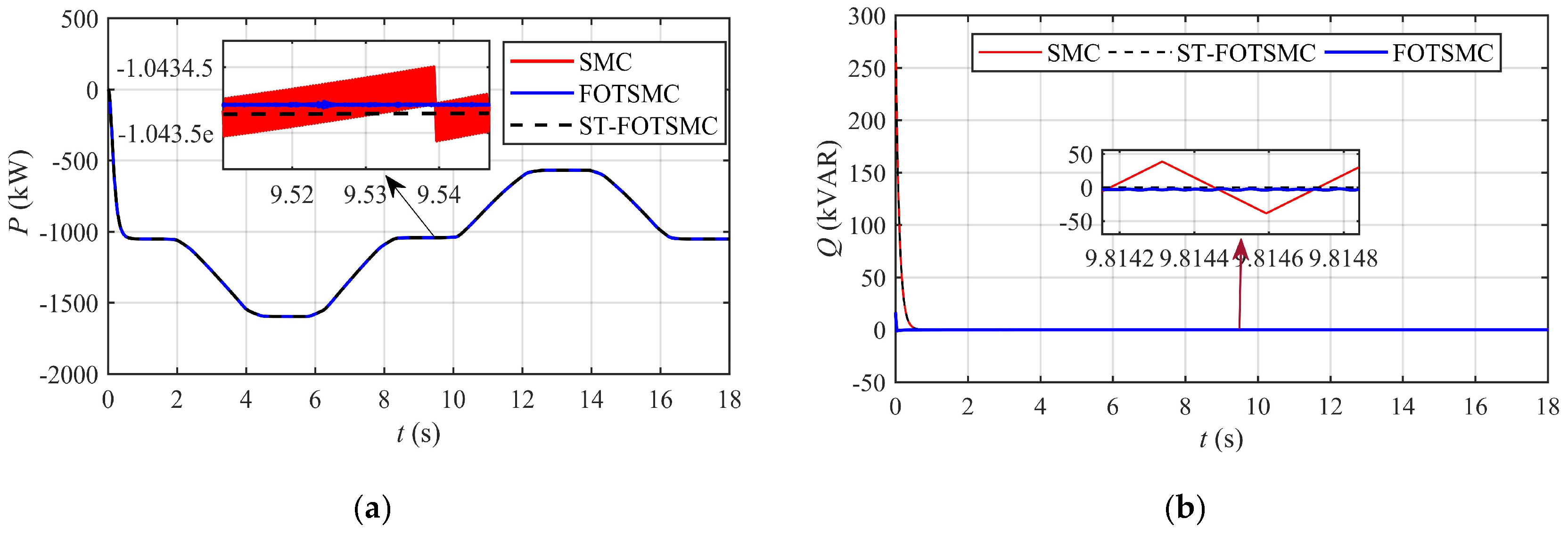


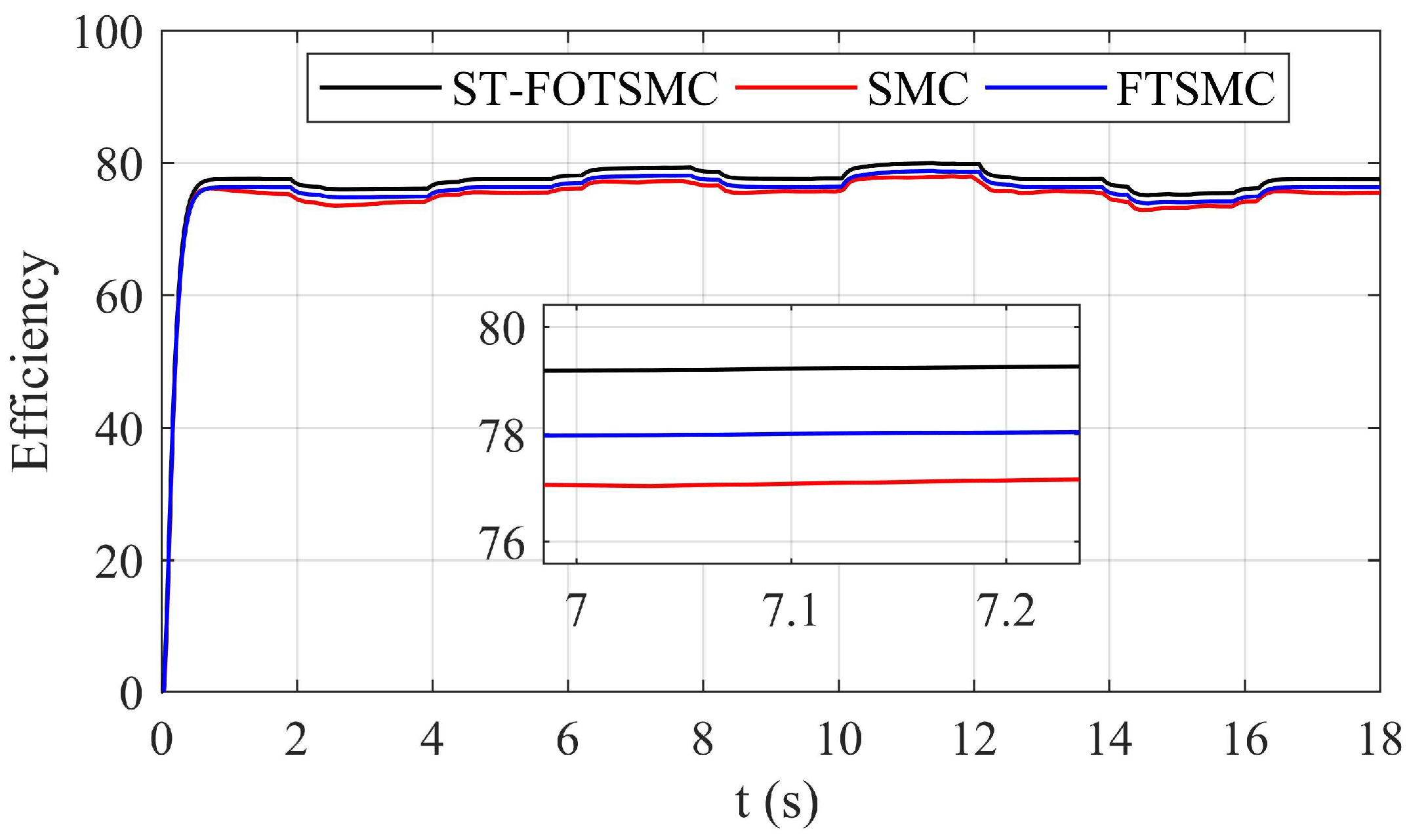
© 2020 by the authors. Licensee MDPI, Basel, Switzerland. This article is an open access article distributed under the terms and conditions of the Creative Commons Attribution (CC BY) license (http://creativecommons.org/licenses/by/4.0/).
Share and Cite
Sami, I.; Ullah, S.; Ali, Z.; Ullah, N.; Ro, J.-S. A Super Twisting Fractional Order Terminal Sliding Mode Control for DFIG-Based Wind Energy Conversion System. Energies 2020, 13, 2158. https://doi.org/10.3390/en13092158
Sami I, Ullah S, Ali Z, Ullah N, Ro J-S. A Super Twisting Fractional Order Terminal Sliding Mode Control for DFIG-Based Wind Energy Conversion System. Energies. 2020; 13(9):2158. https://doi.org/10.3390/en13092158
Chicago/Turabian StyleSami, Irfan, Shafaat Ullah, Zahoor Ali, Nasim Ullah, and Jong-Suk Ro. 2020. "A Super Twisting Fractional Order Terminal Sliding Mode Control for DFIG-Based Wind Energy Conversion System" Energies 13, no. 9: 2158. https://doi.org/10.3390/en13092158








